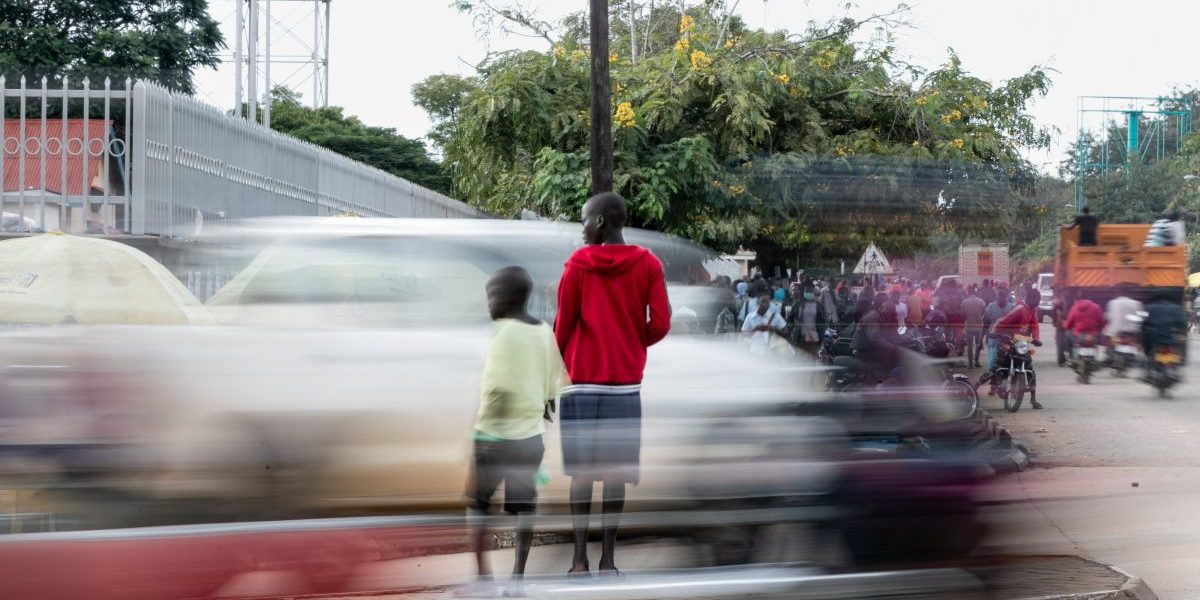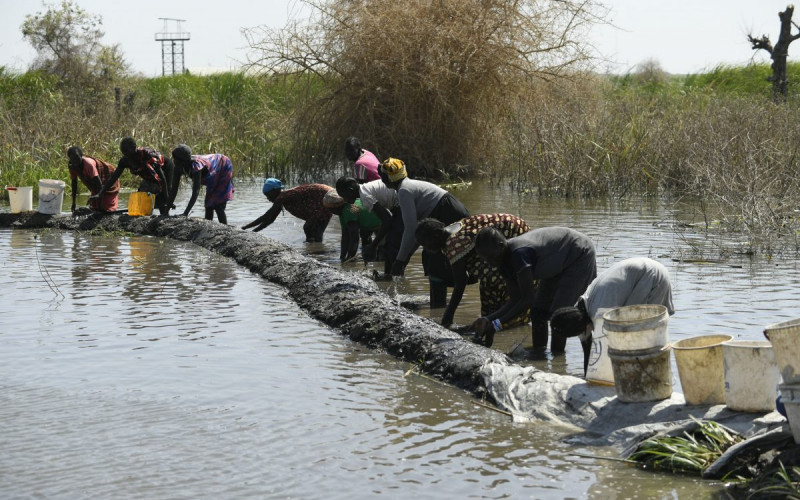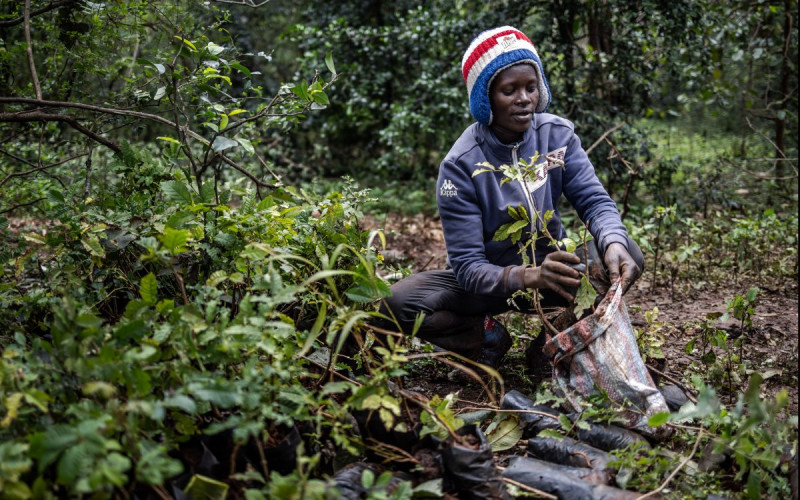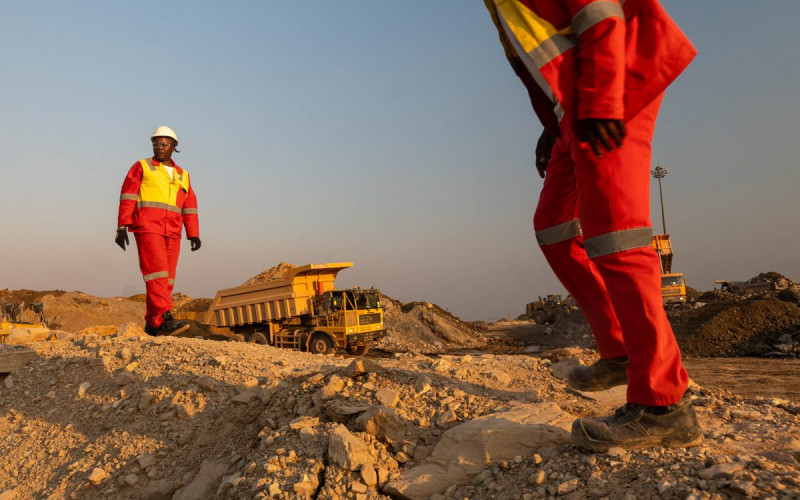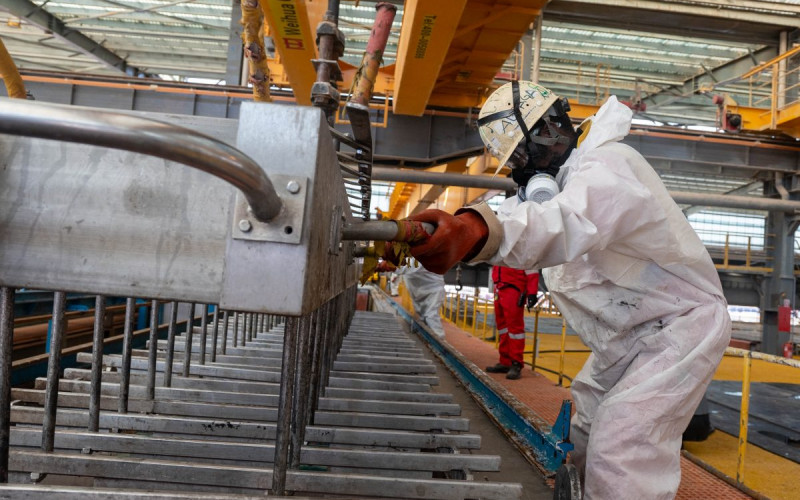Recommendations
- Raise awareness of the human-made nature of climate change, its localised impacts and adaptation options for everyday decisions, particularly among vulnerable and marginalised populations and for climate-exposed sectors.
- Empower women with climate information, adaptive skills, and social and legal protection to bolster their agency in decisions on climate adaptation.
- Increase the availability of African-owned, localised, and timely weather and climate data through improved data collection, analysis, and forecasting capabilities.
- Ensure climate information is available through trusted information and service providers and in languages that minorities and migrant and displaced populations understand, and is shared through communication channels that are accessible, including through local, traditional, and indigenous knowledge systems.
Executive summary
Boosting climate change literacy affords Africa’s people and institutions an opportunity to plan ahead and integrate climate change within core national and sub-national development agendas, such as for education, gender equality, mobility, and poverty reduction. It also provides a key intervention across all levels of society to move from coping responses to climate change to more transformative adaptation responses, including planning for the movement of people due to climate change. To do so, we need to enhance public understanding of climate risks and threats – including through the co-production of actionable climate information services and access to early warnings – in order to support informed decisions on how to adapt.
Introduction
Key development sectors across Africa have already experienced widespread losses and damages attributable to human-caused climate change,1Christopher Trisos et al., “Africa”, in Climate Change 2022: Impacts, Adaptation, and Vulnerability. Contribution of Working Group II to the Sixth Assessment Report of the Intergovernmental Panel on Climate Change, eds. Hans-Otto Pörtner et al. (Cambridge: Cambridge University Press, 2022) 1285. including biodiversity loss, water shortages, reduced food production, loss of lives, and reduced economic growth. The Intergovernmental Panel on Climate Change shows that with every increment of increased global warming, Africa faces further loss and damage across these already impacted areas.2Trisos et al., “Africa”. Many of these individual risks will increase in severity, but they will also compound each other as impacts on water, for example, may cascade into impacts on hydropower, food, health, and labour,3Trisos et al., “Africa”. making adaptation increasingly difficult.
These impacts from climate change are particularly severe for Africa due to its high vulnerability. A component of climate change risk, vulnerability is a result of many interlinked issues concerning poverty, migration, inequality, access to basic services, education, institutions, and governance capacities, often made more complex by past developments, such as histories of colonialism.4Joern Birkmann et al., “Poverty, Livelihoods and Sustainable Development”, in Climate Change 2022: Impacts, Adaptation, and Vulnerability. Contribution of Working Group Ii to the Sixth Assessment Report of the Intergovernmental Panel on Climate Change, eds. Hans-Otto Pörtner et al. (Cambridge: Cambridge University Press, 2022) 1171. For example, livelihoods and economies across the continent rely heavily on climate-exposed sectors,5Trisos et al., “Africa”. including rain-fed agriculture, subsistence and informal sectors. This is particularly true for women-headed households and many traditional ways of life, such as dryland pastoralism. The African Shifts report highlights how risks for women worsen with climate disruption, whether they stay in place or move in response to climate impacts.6Kamal Amakrane et al., African Shifts: The Africa Climate Mobility Report, Addressing Climate-Forced Migration & Displacement, (New York: Global Centre for Climate Mobility and Africa Climate Mobility Initiative, 2022). But vulnerability is also an important focus for its own sake, as it helps improve our understanding of the differential impacts of climate change on people of different gender, race, wealth, social status and other attributes.7Birkmann et al., “Poverty, Livelihoods and Sustainable Development”. Addressing vulnerability to climate change therefore needs to be a key focus of adaptation efforts in Africa as vulnerable population groups in most vulnerable regions have the most urgent need for adaptation.8Birkmann et al., “Poverty, Livelihoods and Sustainable Development”.
Sound adaptation policies enable people and natural ecosystems to adapt together through policy responses that address systemic challenges and encourage synergies between adaptation to climate change, a just energy transition, and progress towards the UN 2030 Sustainable Development Goals (SDGs). Targeting co-benefits to realise multiple objectives will increase the efficiency and cost-effectiveness of climate actions. Advancing climate-resilient development pathways is particularly important in Africa, where adaptation policies are commonly designed under conditions of scarcity of financial, technical, and institutional resources. This can inadvertently lead to trade-offs between adaptation options,9Trisos et al., “Africa”. as well as between adaptation and mitigation options, reinforcing inequality, and failing to address underlying social vulnerabilities.
Building adaptation capacity and reducing vulnerability to climate change are two of the most immediate ways African governments and their partners can reduce climate risk and harmful impacts on the continent. To do so, we need to strategically identify what pivotal interventions would make the greatest impact for adaptation at scale as well as provide co-benefits for Africa’s pressing developmental challenges.
The Intergovernmental Panel on Climate Change identifies five key dimensions of climate-resilient development for Africa: climate finance, governance, cross-sectoral and transboundary solutions, adaptation law, and climate services and climate change literacy.10Trisos et al., “Africa”. Here we look at the role of boosting adaptive capacities through raising climate change literacy in Africa.
Public understanding of climate risk
Across Africa, multiple studies show that public perception of the impacts of climate change is high. A recent survey by Afrobarometer found that over two-thirds of Africans perceived climate conditions for agricultural production had worsened over the past 10 years.11Edem E. Selormey et al., “Change Ahead: Experience and Awareness of Climate Change in Africa”, (Afrobarometer Policy Paper No. 60, 2019): 1–30. Yet, greater climate change literacy and access to actionable climate information can increase people’s sense of agency. Among Africans who have heard of climate change, 71% agree that it should be stopped.12Selormey et al., “Change Ahead”.
However, few understand the human causes of climate change.13Nicholas P. Simpson et al., “Climate Change Literacy in Africa”, Nature Climate Change 11 (2021): 937–944. National climate change literacy rates range from just 23% to 66% of the population across 33 African countries.14Simpson et al., “Climate Change Literacy in Africa”. Importantly, climate change literacy rates are, on average, 12.8% lower for women than men.15Simpson et al., “Climate Change Literacy in Africa”. Almost two-thirds of countries sampled had a difference in climate change literacy rates between men and women greater than 10%. This gender gap is a concern, given that women are often more vulnerable to climate impacts than men.16Trisos et al., “Africa”.
Understanding the human cause of climate change is important. It is a strong predictor of risk perception and can enable responses that go beyond simply reacting to climate change to planning and anticipating more appropriate and transformative actions.
Climate change literacy includes understanding the human causes of climate change and its potential impact on key sectors, economies and livelihoods. Without it, people are less able to make informed adaptation choices or understand climate change as a serious and near-term threat. For example, the African Shifts report projects that around 750 000 people may need to leave Ethiopia’s Adama Valley by 2050 as a result of climate impacts in the region.17Amakrane et al., African Shifts But we know that in such rural areas across many African countries, less than 10% of the population is climate change literate.18Simpson et al., “Climate Change Literacy in Africa”. This means young pastoralists across Africa, for example, are making career and life choices without understanding the immediate and future risks that climate change poses to their way of life. It means that there are millions of business choices being made without adequately factoring in risks such as flooding and potential disruptions to energy, water, and supply chains.19Kate Elizabeth Gannon et al., “Business Experience of Floods and Drought-Related Water and Electricity Supply Disruption in Three Cities in Sub-Saharan Africa During the 2015/2016 El Niño”, Global Sustainability 1 no. e14 (2018): 1–15. Many hydropower and irrigation plans across the continent need this level of climate change literacy to understand, for example, that revenues from hydropower for the Zambezi River Basin could be increasingly variable and up to 58% lower than in a future without climate change.20Trisos et al., “Africa”. Low water levels in Lake Kariba in 2022 led to daily six-hour load management with substantial impacts on the Zambian and Zimbabwean economies. It also left Zimbabwe almost wholly reliant on its ageing coal-fired power plants, while increasing the risk of illegal logging for heating and cooking.21Harry Verhoeven, “The Kariba Dam Is Failing: What That Means for African Hydropower”, Center on Global Energy Policy, Columbia University SIPA, December 7, 2022, Further, there will likely be increasing potential for competition for water between hydropower and irrigated agriculture, and climate change in the Zambezi River basin will add additional stresses to this system.22Spalding-Fecher et al., “The Vulnerability of Hydropower Production in the Zambezi River Basin to the Impacts of Climate Change and Irrigation Development”, Mitigation and Adaptation Strategies for Global Change 21 no. 5 (2016): 721–742.
To prevent the manifold consequences of climate impacts from undermining Africa’s development gains, we need to boost adaptation response capacity through enhanced public understanding of climate risk.
Climate change literacy for climate-resilient development in Africa
Climate-resilient development is a process of implementing adaptation and greenhouse gas mitigation measures to support sustainable development for all.23Trisos et al., “Africa”. It emphasises equity as a core element of sustainable development, as well as conditions for inclusive and sustained economic growth, shared prosperity and decent work for all, taking into account different levels of national development and capacities as encoded in the SDGs.
Education is the strongest predictor of climate change literacy in Africa, followed by mobility, income, and urban residence.24Simpson et al., “Climate Change Literacy in Africa”. These observed drivers of climate change literacy overlap with broader developmental challenges on the continent, affording opportunities for co-benefits between progress towards SDGs and climate action.25Simpson et al., “Climate Change Literacy in Africa”. Overcoming the observed gender gap, boosting climate change literacy for women holds co-benefits with SDG 5 ‘Gender’.26Simpson et al., “Climate Change Literacy in Africa”. Poverty undermines climate change literacy.27Simpson et al., “Climate Change Literacy in Africa”. Perception that droughts and floods are getting worse by low-income communities highlights the disproportionate exposure to climate change impacts among those with least adaptive capacity. Among other things, poverty makes it harder for people to move away from hazardous areas. As such, adaptive migration often requires information, connections, and resources that are out of reach.
Supporting communities with improved and equitable access to climate information and early warning systems could in turn help vulnerable groups in adapting their livelihoods to climatic changes.28Trisos et al., “Africa”. Climate services are designed to give tailored climate information to the end user, such as those working in the agriculture, urban, or health sectors. As such, they complement progress in climate change literacy by generating, tailoring, and providing climate information for use in decision making at all levels of society. Boosting general awareness of climate change and climate risks, together with access to localised climate information, can help us make better decisions on how to cope and adapt, including by moving, either temporarily or permanently.29Amakrane et al., African Shifts.
Most people desire to stay where they live, yet in order to ‘leave no one behind’, adaptation policies also need to be prepared to reduce hazard exposure and the recurring costs of rebuilding by helping people move out of the most risk-prone areas. They must act in concert with development planning to target investments and stimulate economic activity in less at-risk places. To this end, forecasting climate risks and demographic trends and pinpointing ‘hotspot’ areas where people are likely to leave and live, will be critical to inform climate-resilient development strategies at all levels.30Amakrane et al., African Shifts.
Climate services and early warning mechanisms are also highly relevant in many border areas where levels of climate change literacy and an understanding of climate risks are particularly low. Climate impacts and climate mobility can add stress to border communities that are already experiencing violence, instability, and underinvestment. Many African borderlands are already spaces of refuge that host large numbers of refugees and internally displaced people.31Amakrane et al., African Shifts. Various forms of illicit trade and cattle rustling, as well as state border security measures make border crossings perilous for pastoralists. Restrictive border policies trap herders in areas where they are more exposed and vulnerable than if they had been able to migrate. This risks bringing them into conflict with state authorities, other pastoralist groups, or communities that are settled.32Amakrane et al., African Shifts. African communities are generally inclusive of newcomers, and peaceful coexistence is the norm. Yet, in a number of borderland areas, climate and conflict dynamics intersect. In such areas, strengthening dialogue and conflict management mechanisms are needed to address tensions between new entrants and the communities into which they are moving.
The African Shifts report shows that factors such as water availability and crop productivity will affect where people move to and from as climate impacts intensify.33Amakrane et al., African Shifts Anticipating and planning for such climate mobility can enable people to stay sustainably, move with dignity, and be welcomed in new places and communities. Starting with an understanding of these population dynamics can also foster alignment between climate mitigation and adaptation policies that act on the drivers of environmental change and development goals that address people’s vulnerability and sensitivity to such change, including through better designed social protections, early warning systems, and social housing.
The COP27 outcome document34UNFCCC, “Sharm el-Sheikh Implementation Plan”, (Decision -/CP.27, 2022, Agenda Item 2 of the Conference of the Parties serving as the meeting of the Parties to the Paris Agreement at its Fourth Session, UN Framework Convention on Climate Change). recognises that 60% of Africa does not have access to early warning and climate information services and calls for financial commitments in support of achieving universal coverage of early warning systems. To date, climate finance has had a tendency towards mitigation projects, such as renewable energy finance. Putting people and nature together at the heart of climate action enables finance, both public and private, to contribute to long-horizon systemic solutions that build resilience, promote sustainable livelihoods and advance development.
Conclusion
There are clear synergies and co-benefits between the adaptation potential of boosting climate change literacy and the pursuit of the SDGs. For this reason, climate change literacy is identified by the Intergovernmental Panel on Climate Change and the African Union as a key intervention to move from coping to more transformative adaptation responses, including planning for the movement of people.35African Union, African Union Climate Change and Resilient Development Strategy and Action Plan, 2022–2032, (Addis Ababa: African Union, 2022): 1–128. Priority intervention areas to boost climate change literacy identified by the African Union includes increasing regional climate change literacy across all levels of formal and informal education curricula. It also prioritises mainstreaming climate change literacy into targeted sectors most vulnerable to climate change in Africa (across food systems, health, cities, infrastructure, economies, water, heritage, with an emphasis on gender), as well as across government policy and decision makers.36African Union, Climate Change and Resilient Development Strategy and Action Plan.
Boosting climate change literacy would afford Africa’s people and institutions an opportunity to plan ahead and integrate climate change not only in household decision-making but also within core national and sub-national development agendas, such as for education, gender equality, and poverty reduction, thereby supporting more climate resilient development pathways.
Acknowledgement
SAIIA gratefully acknowledges the support of SIDA for this publication.

